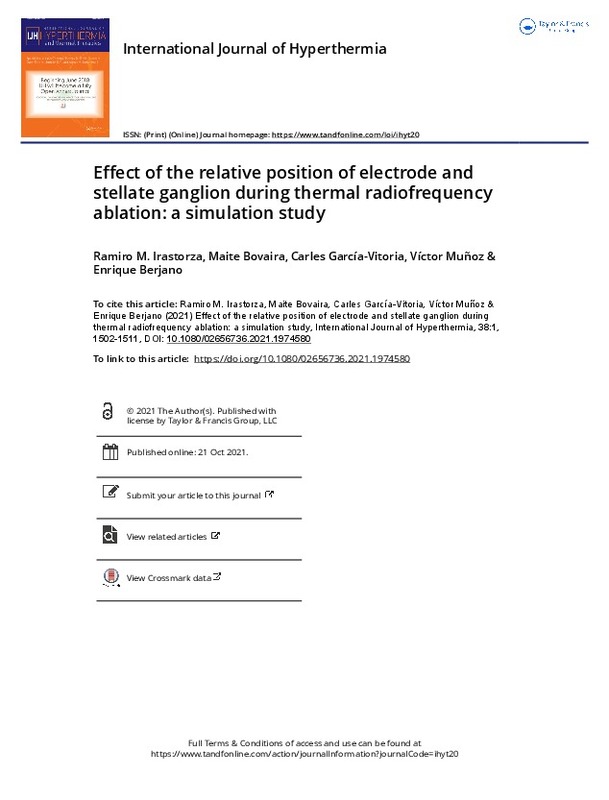JavaScript is disabled for your browser. Some features of this site may not work without it.
Buscar en RiuNet
Listar
Mi cuenta
Estadísticas
Ayuda RiuNet
Admin. UPV
Effect of the relative position of electrode and stellate ganglion during thermal radiofrequency ablation: a simulation study
Mostrar el registro sencillo del ítem
Ficheros en el ítem
| dc.contributor.author | Irastorza, Ramiro M.
|
es_ES |
| dc.contributor.author | Bovaira, Maite
|
es_ES |
| dc.contributor.author | García-Vitoria, Carles
|
es_ES |
| dc.contributor.author | Muñoz, Víctor
|
es_ES |
| dc.contributor.author | Berjano, Enrique
|
es_ES |
| dc.date.accessioned | 2021-11-05T14:06:57Z | |
| dc.date.available | 2021-11-05T14:06:57Z | |
| dc.date.issued | 2021-08-31 | es_ES |
| dc.identifier.issn | 0265-6736 | es_ES |
| dc.identifier.uri | http://hdl.handle.net/10251/176264 | |
| dc.description.abstract | [EN] Purpose Stellate ganglion (SG) block by thermal radiofrequency ablation (RFA) is frequently conducted as a therapeutic intervention for sympathetic-maintained and neuropathic pain syndromes. RFA's partial lack of effectiveness could be partly due to the ablation zone (AZ) not completely covering the SG section and therefore preventing the 'cutting' of the afferent pathways. Our objective was to build a theoretical model to conduct computer simulations to assess the effect of the electrode position relative to the SG. Methods A three-dimensional model was built including the SG and adjacent tissues (vertebrae C7-T1-T2, trachea, carotid artery and vertebral artery). RFA (90-s, 80 degrees C) was simulated considering a 22 G-5 mm electrode. The AZ was computed using the 50 degrees C isotherm. Results An electrode displacement of 2 mm in any direction from the optimal position (centered on the SG) meant that the AZ did not fully cover the SG section. Likewise, SG size considerably affected the RFA effectiveness since the AZ fully covered the section of small but not large SGs. Conclusions The findings suggest that the currently used SG RFA settings (i.e., 22 G-5 mm electrode, 90-s, 80 degrees C) may not be appropriate due to their inability to achieve an AZ that fully covers the SG cross section under certain circumstances, such as a large SG and non-optimal positioning of the RF electrode with respect to the SG center. | es_ES |
| dc.description.sponsorship | This work was supported by the Spanish Ministerio de Ciencia, Innovacion y Universidades under the 'Programa Estatal de I+D+i orientada a los retos de la Sociedad', Grant No 'RTI2018-094357-B-C21', the Universidad Nacional Arturo Jauretche - Argentina 'UNAJ Investiga' [80020170100019UJ], and by the 'Agencia Nacional de Promocion Cientifica y Tecnologica de Argentina' [PICT-2016-2303]. | es_ES |
| dc.language | Inglés | es_ES |
| dc.publisher | Taylor & Francis | es_ES |
| dc.relation.ispartof | International Journal of Hyperthermia | es_ES |
| dc.rights | Reconocimiento (by) | es_ES |
| dc.subject | Computer modeling | es_ES |
| dc.subject | Radiofrequency ablation | es_ES |
| dc.subject | Stellate ganglion block | es_ES |
| dc.subject | Pain relief | es_ES |
| dc.subject | Simulation study | es_ES |
| dc.subject.classification | TECNOLOGIA ELECTRONICA | es_ES |
| dc.title | Effect of the relative position of electrode and stellate ganglion during thermal radiofrequency ablation: a simulation study | es_ES |
| dc.type | Artículo | es_ES |
| dc.identifier.doi | 10.1080/02656736.2021.1974580 | es_ES |
| dc.relation.projectID | info:eu-repo/grantAgreement/AEI/Plan Estatal de Investigación Científica y Técnica y de Innovación 2017-2020/RTI2018-094357-B-C21/ES/MODELADO Y EXPERIMENTACION PARA TERAPIAS ABLATIVAS INNOVADORAS/ | es_ES |
| dc.relation.projectID | info:eu-repo/grantAgreement/ANPCyT//PICT-2016-2303/ | es_ES |
| dc.relation.projectID | info:eu-repo/grantAgreement/Universidad Nacional Arturo Jauretche, Argentina//80020170100019UJ/ | es_ES |
| dc.rights.accessRights | Abierto | es_ES |
| dc.contributor.affiliation | Universitat Politècnica de València. Departamento de Ingeniería Electrónica - Departament d'Enginyeria Electrònica | es_ES |
| dc.description.bibliographicCitation | Irastorza, RM.; Bovaira, M.; García-Vitoria, C.; Muñoz, V.; Berjano, E. (2021). Effect of the relative position of electrode and stellate ganglion during thermal radiofrequency ablation: a simulation study. International Journal of Hyperthermia. 38(1):1502-1511. https://doi.org/10.1080/02656736.2021.1974580 | es_ES |
| dc.description.accrualMethod | S | es_ES |
| dc.relation.publisherversion | https://doi.org/10.1080/02656736.2021.1974580 | es_ES |
| dc.description.upvformatpinicio | 1502 | es_ES |
| dc.description.upvformatpfin | 1511 | es_ES |
| dc.type.version | info:eu-repo/semantics/publishedVersion | es_ES |
| dc.description.volume | 38 | es_ES |
| dc.description.issue | 1 | es_ES |
| dc.identifier.pmid | 34674597 | es_ES |
| dc.relation.pasarela | S\447866 | es_ES |
| dc.contributor.funder | AGENCIA ESTATAL DE INVESTIGACION | es_ES |
| dc.contributor.funder | Universidad Nacional Arturo Jauretche, Argentina | es_ES |
| dc.contributor.funder | Agencia Nacional de Promoción Científica y Tecnológica, Argentina | es_ES |
| upv.costeAPC | 1540 | es_ES |








